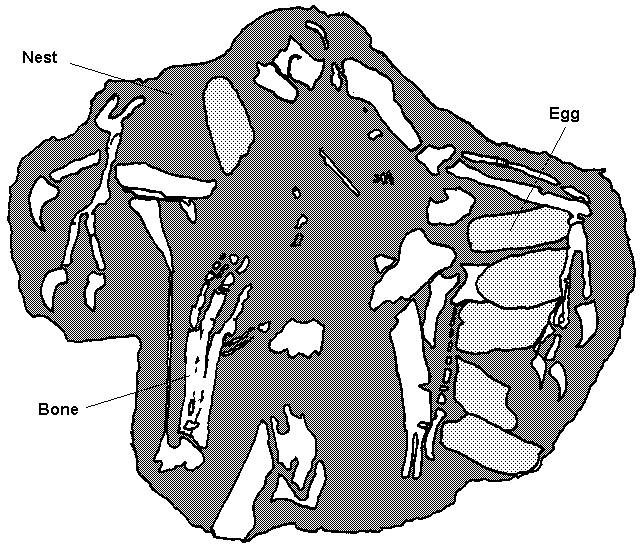|
|
A Brooding Dinosaur? |
|
|
|
A Brooding Dinosaur? |
|
by Laurence D Smart B.Sc.Agr., Dip.Ed., Grad.Dip.Ed
Email: laurence@unmaskingevolution.com
Webpage: www.unmaskingevolution.com
[Free to print and distribute. Copy must be in full.]
The discovery of the fossil of an oviraptor mixed with of a clutch of eggs has strengthened the evolutionary hypothesis that nesting in birds has been inherited from the dinosaurs.
Evolutionary statements now claim that this dinosaur was actually nesting, incubating and protecting its eggs. Consequential statements are now promulgated which state that it has been confirmed that birds inherited their nesting behaviour from their evolutionary predecessors, the oviraptor dinosaurs - as proved by this discovery.

A reconstruction of "the precise position" of the oviraptor on its nest.
(after fig. 2, Nature, Vol. 378, p:775 1995)
What does the original report in Nature state about this fossil?
(1) The fossil, an oviraptor (IGM 100/979), was collected at Ukhaa Tolgod in South Central Mongolia in 1993. (see the drawing below)
(2) The specimen "shows no evidence of transportation after death". [p:774]
(3) The specimen was dug from rock "hypothesised to be deposited by large sandstorms". [p:774]
(4) The specimen "is of a large individual, although it is not outside the range of Ukhaa Tolgod oviraptors." [p:774]
(5) "The skull, vertebrae, tail and dorsal pelvic bones, and proximal parts of both hindlimbs are missing, yet the majority of the remaining [parts] ... are preserved". [p:774]
(6) "Both hind limbs are tightly folded, with the feet and lower legs nearly parallel to one another." [p:774]
(7) Both forelimbs are at opposite edges of the nest, facing backwards. [p:775]
(8) "The eggs in the nest are arranged in a circular pattern, with the broad end of the egg pointing towards the centre of the nest". [p:775]
(9) Fifteen eggs are visible, and it is "estimated that about 22 eggs" are in the nest. [p:775]
(10) Although other nests have been found in the area, "none was discovered close enough to suggest the occurrence of a communal nesting colony". [p:775]

Diagrammatic representation of bones and eggs in position
(after photograph, fig. 1a, Nature, Vol. 378, p:775 1995)
What was actually written about this 'nesting' phenomenon?
(1) "... there is no direct fossil evidence implying advanced parental systems such as those found in modern birds." [p:774]
(2) "[This is] a spectacular fossil specimen that suggests the presence of an avian [bird-like] type of nesting behaviour in oviraptors ..." [p:774]
(3) "The occurrence of multiple specimens of large oviraptorids associated with nests suggests that (1) they were the parents of the nests, (2) that like other archosaurs they habitually stayed close to the nest, and (3) with the addition of IGM 100/992, that they brooded their nests. Unfortunately the nature of the fossil record limits the testing of these hypotheses." [p:776]
(4) "... the sedimentary context of IGM 100/979 and its death position relative to the nest provides compelling evidence of an Oviraptor sitting on a clutch of eggs in a position homologous to the brooding posture displayed by many modern birds." [p:776]
(5) "The nature of fossil preservation at Ukhaa Tolgod (no apparent post-mortem transportation), the near life pose of the oviraptorid skeleton on the nest, and the positive association of these eggs suggest strongly that this is not a chance occurrence." [p:775]
How should we interpret this information?
(1) It is easy to interpret scientific data as if there is only one way that it can possibly be interpreted. Usually however, data can be interpreted in a number of ways.
(2) This concept of a nesting dinosaur is only one way of interpreting the fossil IGM 100/979. The interpretation by the authors sounds very convincing, yet they admit in the article that it is just speculation, not indisputable fact. They correctly use the words "suggest" and "hypothesis" throughout their report because they are interpreting circumstantial evidence - none of the scientists were actually there when the oviraptor was fossilized, so there is no direct evidence.
(3) The scientists candidly admit that "other factors could possibly account for the association found in IGM 100/979 ..... [one] possibility is that the animal perished while in the act of laying eggs in the nest. This seems obviated by the lack of eggs inside the body cavity." [p:775]
(4) This report does not conclusively prove nesting behaviour in dinosaurs, it is just one interpretation of the data. The writers have presented a highly plausible interpretation, but it should only be regarded as a hypothesis, not a fact.
(5) Evolutionists justify their reconstruction of the past by likening their efforts to the work of detectives in solving crime. "The evaluation of historical clues is not unlike a detective's reconstruction of a crime from circumstantial evidence." [N.D. Newell "Creation and Evolution: Myth or Reality", Columbia University Press, p:57 1982]
(6) Remember Lindy Chamberlain? She was convicted by a jury who found her guilty on the circumstantial evidence presented by the prosecution. The prosecution found forensic scientists who interpreted the data the way they were interpreting it, and used these experts to provide compelling evidence showing that she killed Azaria. Lindy was later acquitted of the murder in an appeal because her defence lawyers produced forensic scientists who provided contrary interpretations of the original forensic evidence.
(7) Circumstantial evidence cannot prove an historical fact, only the presence of a witness, or the record of a trusted witness. Circumstantial evidence only provides a degree of probability that something has occurred in the past.
(8) Do not accept as fact any statement that has been justified by circumstantial evidence.
SOURCE - Nature, Vol. 378, p:774-776 1995
![]()